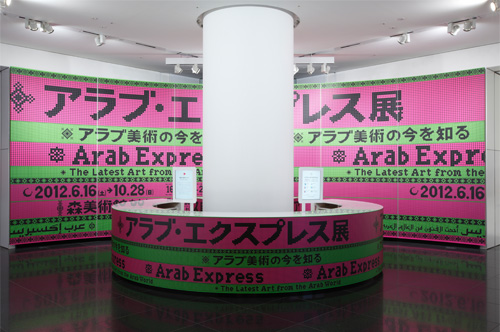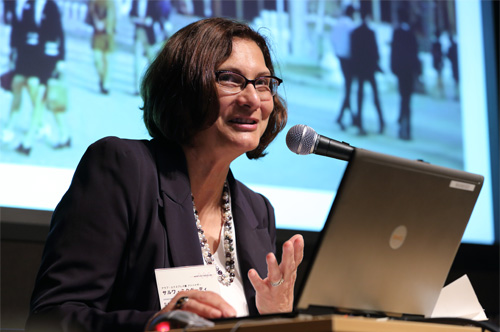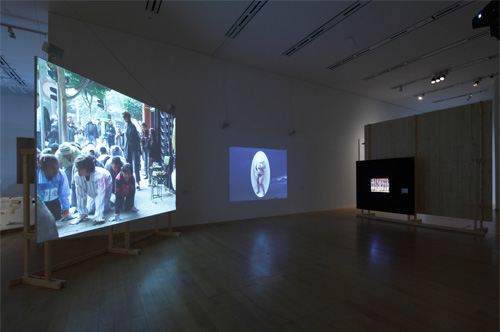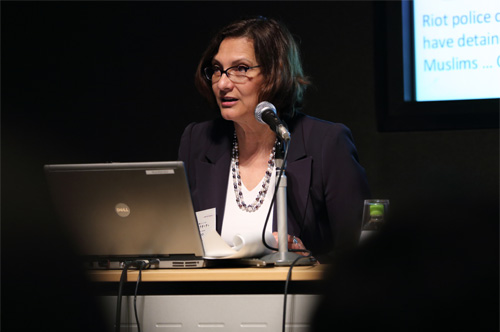The final part of our report on Salwa Mikdadi's keynote lecture at the "Arab Express" symposium. In parts 1 through 3 we looked back over the 20-year period during which Arab art rose to prominence on the international stage, but what direction will Arab art take in the future? And what is the significance of the Arab Spring?

"Arab Express" installation view
Photo: Kioku Keizo
Exchanges between the Arab world and Japan
Japanese artists have been visiting and interacting with Arab artists since the early 1970s. When Japanese artists visited Beirut back then their work appeared in posters in support of the Palestinians. A number of Arab and Japanese artists continue to participate in and initiate projects in Japan and in the Arab countries through residencies, exhibitions and biennials.
The Palestinian artist Vladimir Tamari immigrated to Japan in the early 1970s. His paintings reflect both his adopted home and his memories of Palestine. (Images of Vladimir Tamari's work can be found here)
It is also worth nothing that recently, Yuko Hasegawa, the chief curator of the Museum of Contemporary Art Tokyo, has been selected to curate the 11th edition of the Sharjah Biennial, which opens in March 2013.
This is by no means a comprehensive list of the reasons that bring Arab art to Japan for the first time now and not 10 years ago. But it gives a general overview of the state of Arab art production. Still, there are many more issues to contend with which may leave us with more questions. Some we already know, others we are trying to understand and tackle. Among the most challenging is the task of creating a local discourse in the arts that is not exclusively Western but also grounded in modern Arab thought. Arab art is now read in English. It is time we start reading it in Arabic.

Salwa Mikdadi(Art historian specializing in modern and contemporary art of the Arab world)
Photo: Mikuriya Shinichiro
Arab art should be discussed using the Arabic language
Arab art is not insular and should not be referenced without the other creative arts. The Arabic word for art is funoun which encompasses all the arts: literature, performance, theatre and film. The adoptions of Western definitions for artistic production have their basis in a long history of art specific to Europe. Arab art has its own history and set of reference points and differences that we need to acknowledge and study.
Some of the best writings on modern Arab art were by novelists and poets such as Jabra Ibrahim Jabra, Abdul Rahman Munif and others who published in the 1960s and 1970s and were republished in the early 1990s by Darat al Funun in Jordan. There is a tendency to not only isolate visual artists in silos but also to present contemporary art, and particularly conceptual art, outside the local historical canon. New initiatives to advance scholarship in Arab art are now addressing this issue by contributing analytical reviews on art from the region (The Association for Modern and Contemporary Art of the Arab world, Iran, and Turkey, See website).
Another challenge to understanding Arab art in the local context is the misrepresentation of Arab culture in mainstream Western media, which gives the wrong impressions about Arab youth as pessimistic and prone to extremism and violence.

"Arab Express" installation view
Photo: Kioku Keizo
The Arab Spring is a celebration of life by the Arab people
The Arab Spring showed how much the Arab youth love life. Thousands of peaceful demonstrators showed a culture of peace and a love for life of dignity and justice. In the last 7 years there have been a number of public relations campaigns to promote ideas such as hope, life and optimism, such as the "culture of hope" campaign in Jordan, and the "I love life" campaign in Lebanon. These campaigns, designed by Saatchi and Saatchi and others were funded by local corporations and international entities. Their aim was to transform what is seen as a culture of death to a culture of hope.
In a recent essay on these campaigns, Maysoun Sukkarieh, Professor of Education at the American University of Beirut, draws attention to how the problems of the Arab world are construed primarily as 'matters of culture,' whereby the Arab world and the West are constructed in terms of a stereotyped and Orientalist opposition, and how solutions to such perceived problems are presented as requiring 'cultural reforms.' Sukkaryeh elaborates; "Such 'cultural reforms' are meant to solicit popular participation in the neoliberal restructuring of the Arab world." However, the Arab Spring has shown that Arab people do have a voice that has been suppressed for decades and that Arab culture does celebrate life in all its forms: in novels, cinema, art, theater, dance, and in poetry. Arabs do not need a PR campaign to learn how to love life. Just listen to the hopes and dreams of the Arab youth, rapping and singing, drawing calligraffitti, and dancing to express their long sought freedom to love life without restrictions. Arabs are demanding jobs, social justice, basic human rights and political inclusion.
The Arab Spring is a celebration of life, and here I end on a positive note with a quote from the 17th century Japanese poet, Matsuo Basho:
"There is nothing you can see that is not a flower; there is nothing you can think that is not the moon."

Salwa Mikdadi(Art historian specializing in modern and contemporary art of the Arab world)
Photo: Mikuriya Shinichiro
Salwa Mikdadi(Art historian specializing in modern and contemporary art of the Arab world)
Salwa Mikdadi is an art historian and curator specializing in art from the Arab world, gender and politics in art, museums and Arab art institutions. She curated the first Palestinian Pavilion for the 2009 Venice Biennial and was co-editor of New Visions: Contemporary Arab Art of the 21st Century. She also contributed to the Metropolitan Museum of Art Timeline of Art History web site. Until recently she headed the Arts and Culture Program at the Emirates Foundation in the UAE. In the past she has directed the Cultural & Visual Arts Resource/ICWA (1989-2004), and is a founding member of the Association of Modern and Contemporary Art of Arab World, Iran, & Turkey. She holds a Masters degree in Museum Studies from J. F. Kennedy University and is a consultant and lecturer on the art of the Arab world.
■Relevant information
・Today's Arab Art
Part 1 Arab art under the world spotlight
Part 2 Arab artists on the rise
Part 3 The future of ever-changing Arab art
Part 4 The Arab Spring and its impact on art
・Arab Express: The Latest Art from the Arab World
June 16 - October 28, 2012
・"Arab Express: The Latest Art from the Arab World" photos from installation period (flickr)
・"Arab Express: The Latest Art from the Arab World" Installation view (flickr)
Section 1
Section 2
Section 3 & "Arab Lounge"
・Interview: Nanjo Fumio on "Arab Express"
Part 1 Comparing the Arab world of the 1970s with that of today
Part 2 Why is the world fascinated with Arab contemporary art?
Part 3 An exhibition to encourage cultural diplomacy, mutual understanding
・Interview: Kondo Kenichi on "Arab Express"
Part 1 Want to show Japan the diversity of the Arab world
Part 2 Exhibition highlights: Black Fountain and "Arab Lounge"








